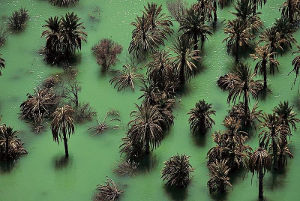The management of natural catastrophes risks in Algeria
Vast areas around the world are affected by these catastrophes which hit all the continents. There is ground for concerns not only for the regions recently affected by the catastrophes but also for the areas susceptible to these phenomena.
In the Mediterranean basin, Algeria is known for its seismic vulnerability and its exposure to floods. Ten years after the dramatic events of Bab El Oued, Algiers’ symbolic neighborhood, the Compagnie Centrale de Réassurance (CCR) held on November 10, 2011, an international seminar, a sort of stocktaking on the perspective of the current obligation of natural catastrophes insurance.
The Algerian system for the coverage of natural catastrophes risks
The Algerian system for the coverage of these risks came into being in 1980 with the enactment of the law 80-07, which then enabled insurers to extend the guarantees offered by fire contracts to natural catastrophes. Yet, only in 2004 did the system start to take its current shape.
 El Kantara dam in Biskra © Astonar, CC BY-SA 3.0 El Kantara dam in Biskra © Astonar, CC BY-SA 3.0 |
In light of the scale of the damages and human losses caused by Bab El Oued floods in 2001 and the 2003 Boumerdès earthquake, underwriting natural catastrophe risks has become compulsory.
The cover comprises four guarantees: earthquake, flood, storm and mudslide. Real estate, commercial and industrial properties are insured with the tariff being imposed by the government. A deductible per claim is supported by the policyholder. A copy of the insurance contract is required for any cession or lease of property or during an income tax return carried out by any individual bound by this obligation. It is up to the State to determine whether a claim is characterized as a natural catastrophe or not.
A few years after the law came into force, a first assessment established by CCR revealed a poor underwriting rate of about 4% for private dwellings and of 8% for the entire industrial installations. The overall written premium in 2010 amounts to 1 321 532 458 DZD (16.47 million USD).
Reinsurance of natural catastrophes risks
Reinsurance of natural catastrophes risk is done at two levels.
Local ceding companies get reinsured at CCR by means of two covers for the entire market. A first treaty on a quota-share basis with a capacity worth 2 500 000 000 DZD (31.2 million USD), 30% of which is retained by ceding companies and 70% ceded to the national reinsurer. A second treaty, stop-loss, covers the retention of ceding companies on unlimited basis (thanks to the government’s guarantee) starting from a priority of 100%.
In 2010, the premium ceded to CCR by local ceding companies amounted to 925 072 721 DZD (11.53 million USD).
At the level of CCR, market protection is ensured by means of the Algerian Catastrophe Insurance Program pool for natural catastrophes (ACIP), established for this purpose. The pool’s capacity amounts to 250 000 000 USD. The premium ceded to the retrocessionnaires is of 7 192 000 USD in 2010.
The main natural catastrophes affecting Algeria during the last thirty years
in millions USD| Region | Nature | Economic losses | Human losses | |
|---|---|---|---|---|
1980 | Wilaya of Chlef | Earthquake | 2 000 | 3500 dead & 4500 injured |
1994 | Mascara | Earthquake | 50 | 175 dead |
2001 | Bab El Oued (Algiers) | Floods | 320 | 800 dead |
2003 | Boumerdès | Earthquake | 5 000, 50 of which of insured losses | 2300 dead |
2008 | Ghardaïa | Floods | 352 | 43 dead & 86 injured |
2011 | El Bayadh | Floods | 81 | 10 dead |